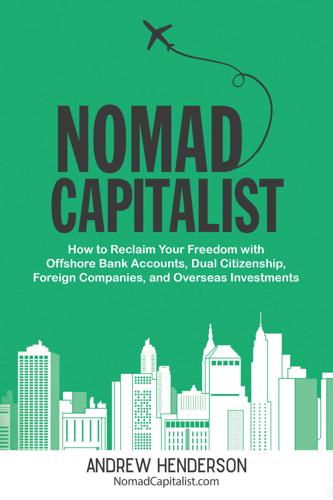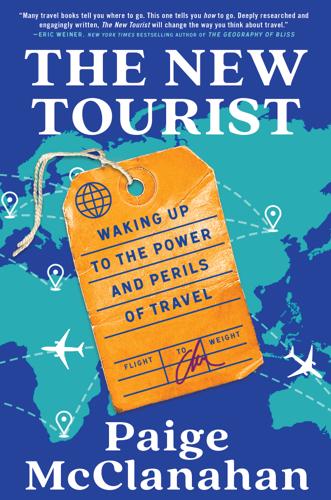birth tourism
description: the practice of travelling to another country for the purpose of giving birth there
6 results

Nomad Capitalist: How to Reclaim Your Freedom With Offshore Bank Accounts, Dual Citizenship, Foreign Companies, and Overseas Investments
by
Andrew Henderson
Published 8 Apr 2018
You had no choice in the matter, but because your mother went into labor on a certain point on the map, you inherited characteristics, responsibilities, and debts through the age-old ‘social contract.’ However, you can flip the script on this situation by using many of the strategies in this book to benefit from the system in a sort of government arbitrage by which you take the best parts of each country while tossing the worst parts. One way to do this is through birth tourism. Birth Tourism As Pete and I discussed the merits of his theory, we discussed an entirely different angle of giving birth: birthright citizenship. The concept of birthright citizenship means that certain countries grant citizenship to anyone who is born there, regardless of status. As we discussed in Chapter Four, most of Europe and Asia determine an individual’s citizenship by their parents.
…
Not only will this save them the time and money that you invested in reading this book but it will set them up to take advantage of any number of opportunities as they get older. It could also get you a new passport, as well. So, where can you give birth to give your kids a leg up in the second citizenship department? Sadly, not in Europe; Ireland was the last European nation to abolish their law allowing birth tourism some time ago. The countries to investigate are the pro-immigration countries where anyone can fit in. The Americas fit the bill, with Colombia being one of the few exceptions. One of the most interesting loopholes is the island of Dominica, which sells citizenship for $100,000 per person, yet grants citizenship to children at birth for the cost of a few low fees.
…
If you are a citizen of a high-tax country, your children can have the perks of your home country passport as well as the benefits of a more laid-back country that is not on the warpath for cash. They will also be able to travel, live, and work in a wide variety of locales. What better start in life could you possibly give your progeny? World Schooling Concepts like birth tourism are part of the remedy to one issue I see again and again in my line of work. The problem is that even those who decide to live overseas to save a boatload on taxes and create a lifestyle of freedom tend to think that they will eventually have to move back home. About a year ago, I began working with Patrick, a young Australian businessman who admitted that he was in this camp.

The Human City: Urbanism for the Rest of Us
by
Joel Kotkin
Published 11 Apr 2016
This is evident in the rising emigration from cities such as Hong Kong and Singapore, where roughly one in 10 citizens65 now chooses to settle abroad and nearly half would consider a move, mostly to lower-density countries like Australia, Canada, and the United States.66 Some Chinese mothers, in order to give birth to future American citizens, actually indulge in “birth tourism” so they can have their children in places such as Los Angeles and Orange Counties, where the vast majority of Asians live in family-centric suburban communities.67 The reluctance of people to have children in dense cities suggests that super-urbanity often serves as a kind of way station in which people spend only a portion—often an exciting and career-enhancing one—of their early lives.
…
See also Eastern Asia densification in, 45 emergence of “generic cities” in, 105–106 glamour zones in, 81 global cities in, 81, 90 immigrants to, 87 infrastructure lack in, 69 population growth in, 50 shift of business to rural areas in, 74 vertical cities in, 70–71 Athens, 187 Athens, ancient, 23, 56, 85 Atlanta, 152, 156 Australia agricultural land in, 193 city parks in, 23 dispersion in, 154 house size in, 179 housing shortage in, 175 job growth in suburban areas, 184 middle class move to periphery in, 116 migration to, 137 millennial living preferences in, 173 minorities in suburbs of, 158–159 multigenerational households in, 183 seniors in workforce in, 181 seniors’ living preferences in, 181 suburban inequality in, 150 war against suburbia in, 147–148 Australian Conservation Foundation, 11 B Babylon, 22 Baghdad, 85 Bajpai, Kanti, 75 Balk, Deborah, 61 Baltimore, 9, 32 Bangalore, 54, 74 Bangkok, 53 Bangladesh, 124 Bankstown, Australia, 158 Barbier, Edward, 193 Bartlett, Dana, 176 Bazzy, Doug, 143 Beijing air pollution in, 66 appeal of, 22 Beihar Park, 23 dispersion in, 155 as global city, 90, 92 housing prices in, 175 and immigration, 87 as imperial city, 24 as political power center, 25 population of, 51, 74 post-familialism in, 120 as walled city, 57–58 Beirut, 126 Bell, Daniel A., 104 Bellevue, Washington, 184 Berger, Peter, 114 Berlin conditions in 19th century, 59 global influence of, 82 as imperial city, 24 population of, 115 post-familialism in, 118 socialist planning in, 35–36 Birth tourism, 16 Blake, Peter, 146 Bloomberg, Michael, 13, 39 Bogart, William, 187 Bogotá, 54 Bolick, Kate, 128 Bombay, 28, 60. See also Mumbai Bookman, Jay, 152 Boorman, John, 149 Boston children in, 16 decreased diversity in, 42 density of, 183 financial jobs in, 186 as luxury-oriented city, 40 post-familialism in, 128 reinvention of city center in, 31 as transactional city, 32 Boston Globe, 40 Brand, Stewart, 9–10, 72 Brasília, 163 Braudel, Fernand, 2 on Amsterdam’s population, 86 on everyday life, 19 on history, 201 on inertia, 87 on New York City, 37–38 on separate demography for the rich, 57 on suburbs, 170 Brave New world (Huxley), 139 Brazil aging population in, 124–125 declining growth rate in, 55 megacity growth in, 73 protests against development priorities in, 13 urbanization in, 53 Bridgeport, 183 Britain.
…
See also Great Britain foreigners in workforce of, 97 housing shortage in, 175 infrastructure of, 67 migration to, 85, 137 minorities in suburbs of, 158 tech employment in, 185 telecommuters in, 188 war against suburbia in, 147 United States affordable housing in, 195 aging population of, 180 birth tourism in, 16 changes in suburbs of, 156–158 childlessness and density in, 116 desire for marriage and children in, 180 dispersion in, 149–151, 162 dispersion in early 20th century, 30 early industrial cities in, 58 farmland losses in, 193 forms of housing in, 117 gay households in, 179 high-income metropolitan areas in, 183 house size in, 179 housing affordability in, 133–134, 160 immigrants to, 98 improved sanitation in, 116 megacities in, 52 Mexican immigration to, 139 migration to, 137 millennials in, 170–171 movement of city center populations in, 165 multigenerational households in, 182–183 post-familialism in, 130, 133–134 public transit in, 187 quality of global cities in, 95–96 secularism in, 126 seniors in workforce in, 181 shift to suburbia in, 14–15 single-person households in, 179 suburban growth rates in, 152 suburbs as “new slums” in, 159 telecommuters in, 188 urban employment in, 184 war against suburbia in, 146–148 women in workforce in, 135 Unité urbaines, 269n5 Urban areas, 6, 169, 269n5 Urban future, 169–201 choices for citizens, 196–198 and densification in suburbs, 178–179 economic role of central city, 185–186 economics of dispersion, 183–185 familialism, 179–180 focus on small units, 200–201 global housing shortage, 173–175 greening of suburbs, 189–191 home-based economy, 187–189 housing prices, 198–199 job decentralization and commuting, 186–187 millennial choices, 170–173 multigenerational households, 182–183 neo-Malthusian urbanism, 192–194 organic expansion of cities, 199–200 population size, 194–196 reconnecting with nature, 191–192 reviving older suburbs, 177 senior housing choices, 180–182 village-like development, 175–177 Urban growth boundaries of, 11 current dominant approach to, 169 death rates in cities, 115 in developing world, 169 organic expansion, 199–200 Urban heat island effect, 190–191 Urban hierarchy, 82–83 Urban Land Institute (ULI), 7–8 Urban planners desires of citizens vs., 6–7, 12–13, 20, 155, 201 opposition to densification by, 178 on social cohesion, 163 Urban pluralism, 170 “Urban tribes,” 127–128 Uruguay, 53 V Valencia, California, 177 Value systems, 125–126, 137 Vancouver, 117, 152 Venezuela, 53 Venice, 25, 32, 81, 85 Vernon, Raymond, 17 Viacom, 130 Vienna, 24, 59 Vietnam, 124 Village-like development, 176–177 Villages, economic growth in, 76 VIP zone of cities, 65 W Waldie, D.

The Passenger
by
AA.VV.
Published 23 May 2022
Activists called for solidarity among Asians of all ethnicities, as well as Africans, Latinos, and Native Americans. MATERNITY HOTELS The law granting citizenship to anyone born on US soil was designed to regularise those who had been freed from slavery, and today it guarantees fundamental rights for the children of immigrants. As a consequence, a birth tourism sector has developed in the USA, the extent of which varies according to estimates (and the political spin of the person doing the calculation). In California, the most popular state, an industry has sprung up to serve these travellers, who mostly arrive from China; it is a practice at the limits of legality for the couples (although not actually illegal), and it will mean their offspring will have to make a difficult choice when they turn twenty-one because China does not allow dual citizenship.

The New Tourist: Waking Up to the Power and Perils of Travel
by
Paige McClanahan
Published 17 Jun 2024
Even Twain, an outright supporter of the tourist enterprise, recognized the comedy inherent in the tourist’s earnest desire to travel, at one point calling himself and his companions “a pack of blockheads… galloping about the world, and looking wise, and imagining we are finding out a good deal about it!” But gallop about they did. A hundred years after its etymological birth, tourism was still the domain of the rich—though it was no longer the exclusive domain of the superrich—and it was beginning to take on some of the structures and attitudes whose echoes we can still see today. But tourism before the world wars was still something of an oddball activity—a quixotic quest for those “new pilgrims” who could afford it.

The Future Is Asian
by
Parag Khanna
Published 5 Feb 2019
Real estate developers are preparing ever more materials in Chinese to speed up the deal making. In 2017, Berkshire Hathaway launched a partnership with the Chinese property site Juwai.com to reach an even larger Chinese audience.19 By some estimates, a similar number of Asian “anchor babies” are born each year in the United States to women engaging in birth tourism.20 Students constitute the largest flow of Asians into the United States. Chinese lead the way with nearly 100,000 new arrivals each year, and a total of about 300,000 Chinese are currently enrolled in US educational institutions. India, South Korea, and Saudi Arabia are the next three largest sources of foreign students in the United States, with each sending more than Canada.

Lonely Planet China (Travel Guide)
by
Lonely Planet
and
Shawn Low
Published 1 Apr 2015
Another consequence of the one-child policy was a rapidly ageing population, with over a quarter of the populace predicted to be over the age of sixty-five by 2050. As women can have a second child abroad, this also led to large numbers of mainland women giving birth in Hong Kong (where the child also qualified for Hong Kong citizenship). The Hong Kong government has used new legislation to curb this phenomenon, dubbed ‘birth tourism’, as government figures revealed that almost half of babies born in the territory in 2010 were born to mainland parents. In 2013, the Hong Kong government prohibited mainland women from visiting Hong Kong to give birth, unless their husband is from the territory. Women in China Equality & Emancipation Growing up in a Confucian culture, women in China traditionally encountered great prejudice and acquired a far lowlier social status to men.